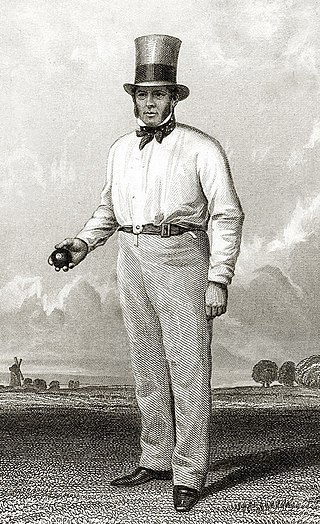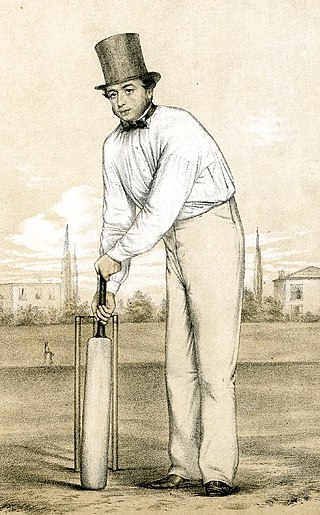- 1 2 3 In the period Ashby played, the number of balls delivered by a bowler and the runs conceded from them were generally not recorded. As a result, it is impossible to know how many balls he delivered, his best bowling figures or his bowling average.
- ↑ In the period Ashby played, wickets taken by bowlers were normally only recorded if they were bowled. Other means of dismissal were not credited to any bowler. [2] As a result the number of wickets he took is uncertain, with the total of 164 being a minimum. This also makes the calculation of an accurate bowling average impossible.
- ↑ Roundarm bowling involves delivering the ball from below the level of the shoulder. At the time Ashby and Willes began to play, the normal form of delivery was underarm bowling, either rolling or pitching the ball. Roundarm bowling, which gave the bowler an advantage, was specifically outlawed in 1816. Although Willes is often credited with the invention of the roundarm style, it had been in use since at least the 1780s, although it had been outlawed at the time by the Hambledon Club, an influential cricket club based in Hampshire. [5]
- ↑ Ashby played 14 times for both Kent sides and England sides in first-class matches. [4]
- ↑ During the time Ashby played, England sides were not representative of the country. Instead, they were sides composed of players from a range of locations brought together to play against another side. [10] So when Ashby made his first-class debut for an England XI in 1808 he played against a Surrey side in a team made up of players from other parts of the country, including Hampshire, Middlesex and Kent. [11]
- ↑ Beauclerk was a leading opponent of roundarm bowling. [1]
Related Research Articles
In cricket, roundarm bowling is a bowling style that was introduced in the first quarter of the 19th century and largely superseded underarm bowling by the 1830s. Using a roundarm action, the bowlers extend their arm about 90 degrees from their body at the point where they release the ball. Roundarm fell into decline after 1864 when the current style of overarm bowling was legalised, although W. G. Grace continued to use it to the end of his career.

The Reverend Lord Frederick de Vere Beauclerk, a 19th-century Anglican priest, was an outstanding but controversial English first-class cricketer, the leading "amateur" player of the Napoleonic period.

William Clarke was an English cricketer and team manager who played first-class cricket from 1826 to 1855. He founded, managed and captained the All-England Eleven. He has been described as "one of certain figures who, in the history of cricket, stand like milestones along the way". Clarke was born at Nottingham and died at Wandsworth in Surrey.
William Bowra was an English cricketer who played in 50 first-class matches between 1775 and 1792.
William Bullen was a leading English cricketer throughout the last quarter of the 18th century, his known career spanning the years 1773 to 1800. He was an all-rounder who probably batted right-handed. He played mainly for Kent sides although he also appeared for England XIs and a variety of other sides.
1807 was the 21st season of cricket in England since the foundation of Marylebone Cricket Club (MCC). John Willes of Kent first tried to revive the idea of "straight-armed" bowling, which had originated with Tom Walker in the 1790s.

Frederick William Lillywhite was an English first-class cricketer during the game's roundarm era. One of the main protagonists in the legalisation of roundarm, he was one of the most successful bowlers of his era. His status is borne out by his nickname: The Nonpareil.
John Willes was an English cricketer who, although he played in only five first-class cricket matches, had a significant impact on the game's history and development. Willes played for Kent county cricket teams and was a fast bowler who had a "pivotal" role in the development of roundarm bowling.
Charles Joseph Harenc was an English lawyer and amateur cricketer in the mid-19th century. He played cricket for the Gentlemen of Kent, the Kent County Cricket Club teams of the 1840s and for MCC as well as a number of other sides and was regarded as the best Gentleman bowler of his era.
James Bray Baker was an English cricketer who played first-class cricket from 1816 to 1828. He was born at Hailsham in Sussex and was mainly associated with Sussex cricket teams.
William Barton was an English cricketer who played first-class cricket for a large number of sides during the period between 1795 and 1817.
Herbert Jenner was an English barrister. As an amateur cricketer he played first-class cricket from 1825 to 1838. He changed his name to Herbert Jenner-Fust in 1864.

William Martingell, also known as Will Martingell, was an English professional cricketer who played first-class cricket between 1839 and 1860. He played primarily for Kent County Cricket Club and Surrey County Cricket Club, making over 180 first-class appearances during his career.

Richard Mills was an English professional cricketer who played first-class cricket between 1825 and 1843, primarily for teams in Kent. He was considered one of the best professional cricketers of his era.
Horace Bates was an English cricketer who played first-class cricket from 1822 to 1832.
Edward Thwaites was an English professional cricketer who played first-class cricket between 1825 and 1837. He played in 25 first-class matches, including for the Players in 1827.
George Betts was an influential English cattle trader and butcher who played two matches of first-class cricket during the 1830s.
Henry Croxford was an English professional cricketer who played for Kent County Cricket Club during the 19th century. He was born at Hadlow in Kent in 1845, the son of William and Sophia Croxford. His father was a boot maker.
Through the Napoleonic Wars, county cricket virtually died as cricket was impacted by losses of investment and manpower.
References
- 1 2 3 4 5 6 7 8 Carlaw, pp. 30–31.
- ↑ Carlaw, p. 31. Retrieved 2022-04-08.
- 1 2 William Ashby, CricInfo. Retrieved 2020-01-01.
- 1 2 3 William Ashby, CricketArchive. Retrieved 2018-04-10. (subscription required)
- ↑ Williamson M (2006a) The evolution of bowling, CricInfo, 2006-05-27. Retrieved 2022-04-08.
- ↑ Carlaw, pp. 577–579. Retrieved 2022-04-08.
- ↑ Williamson M (2006b) A question of degree, CricInfo, 2006-05-30. Retrieved 2022-04-08.
- ↑ Quoted in Carlaw, p. 31. Retrieved 2022-04-08.
- ↑ Denison, p. 22.
- ↑ Birley, p. 364.
- ↑ England v Surrey XI, July 05–06, 1808 – scorecard, CricInfo. Retrieved 2022-08-09.
- ↑ Birley, pp. 64–65.
- ↑ Moore, p. 24.
- ↑ Denison, p. 55.
- ↑ Rendell & Booth, pp. 22–24.
Bibliography
- Birley D (1999) A Social History of English Cricket. London: Aurum Press. ISBN 978 1 78131 1769
- Carlaw D (2020) Kent County Cricketers A to Z. Part One: 1806–1914 (revised edition). (Available online at The Association of Cricket Statisticians and Historians. Retrieved 2020-12-21.)
- Denison W (1846) Sketches of the Players. London: Simpkin, Marshall & Co. (Available online at Google Books. Retrieved 2022-04-08.)
- Moore D (1988) The History of Kent County Cricket Club. London: Christopher Helm. ISBN 0-7470-2209-7
- Rendell B, Booth K (2010) Fuller Pilch: A Straightforward Man. Nottingham: The Association of Cricket Statisticians and Historians. ISBN 9781905138975
External links
Text is available under the CC BY-SA 4.0 license; additional terms may apply.
Images, videos and audio are available under their respective licenses.
| Personal information | |
|---|---|
| Born | 12 January 1786 Linton, Kent, England |
| Died | 10 April 1847 (aged 61) Lambeth, Surrey, England |
| Batting | Right-handed |
| Bowling | Right-arm slow [1] |
| Role | Bowler |
| Domestic team information | |
| Years | Team |